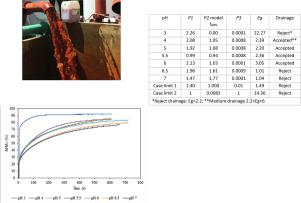Science of the Total Environment ( IF 8.2 ) Pub Date : 2020-06-29 , DOI: 10.1016/j.scitotenv.2020.140251 S Garrido-Hoyos 1 , K Garcia 1 , E Miranda 2 , B López 3 , J Briseño 3

|
Water for human consumption containing arsenic from natural and anthropogenic sources is a public health problem worldwide. Therefore, different technologies must be used to remove it from the water (coagulation-filtration assisted with ferric chloride, adsorption, membranes, etc.). While these technologies produce water that is free from arsenic, they also produce toxic residuals with high arsenic concentrations, which must be treated in order to decrease their volume and thereby facilitate transport and final disposal. Thus, the main purpose of this investigation was to study the physical and chemical properties of arsenic iron sludge in thickening, chemical conditioning, and dewatering processes, as well as to propose new kinetic criteria for obtaining the drainage index (Eg) based on polymer dose, mesh permeability, specific resistance to filtration, and pH. We found a significant improvement in the physical and chemical properties when thickening the sludge, in particular, floc size increased and specific resistance to filtration and Z-potential decreased due to weakened repulsive forces, resulting in more sedimentation. The polymer AN913VHM (PF2) had the best behavior in the chemical conditioning and dewatering tests, with an optimal dose of 8 mg/L and a mesh permeability of 80–100 ft3/min ft2, which made it possible to retain more flocs (60% in 3.74 min). The pH affected the amount of total solids in the cake, with more solids obtained at a pH of 6 (25.93 g/L) and 6.5 (21.81 g/L), and with rapid drainage of surface water (69.28%). Furthermore, new kinetic criteria were obtained for a drainage time of 120 s in order to eliminate 60% of the total volume of the filtrate mass, with Eg of 3.05 at a pH of 6. This value is considered medium drainage for this type of sludge, which is difficult to treat.
中文翻译:

在砷铁污泥脱水中,动力学和排水指数随pH的变化而变化。
人类消费的水中含有来自自然和人为来源的砷,这是世界范围内的公共卫生问题。因此,不同的技术必须用于从水中(用氯化铁,吸附,膜,辅助凝结过滤移除等)。尽管这些技术产生的水不含砷,但它们还会产生高砷浓度的有毒残留物,必须对其进行处理以减少其体积,从而促进运输和最终处置。因此,本研究的主要目的是研究砷铁污泥在增稠,化学调节和脱水过程中的物理和化学性质,并为获得排水指数(E g)提出新的动力学标准。)取决于聚合物的用量,筛孔渗透性,比过滤抗性和pH值。我们发现,当增稠污泥时,物理和化学性能得到了显着改善,特别是絮凝物的尺寸增加,并且由于排斥力减弱而导致过滤和Z电位的比电阻降低,从而导致更多的沉淀。聚合物AN913VHM(PF2)在化学调节和脱水测试中表现最佳,最佳剂量为8 mg / L,筛孔渗透率为80–100 ft 3 / min ft 2,这使得保留更多的絮状物成为可能(3.74分钟内占60%)。pH值影响滤饼中的总固体量,在6(25.93 g / L)和6.5(21.81 g / L)的pH值下获得的固体更多,地表水快速排干(69.28%)。此外,为消除120 s的滤出液总体积的60%,获得了新的动力学标准,在pH值为6的条件下,E g为3.05。污泥,很难处理。











































 京公网安备 11010802027423号
京公网安备 11010802027423号